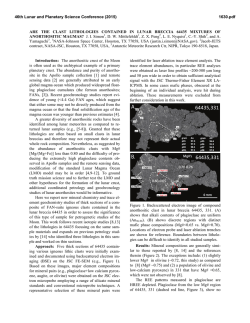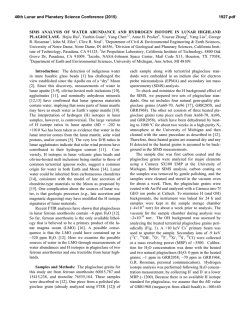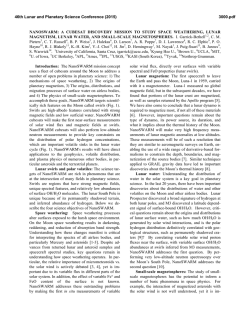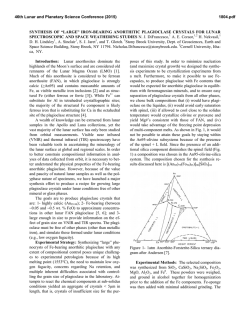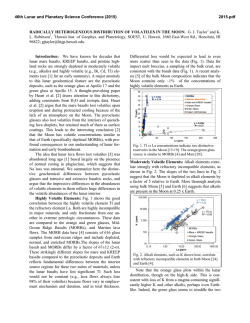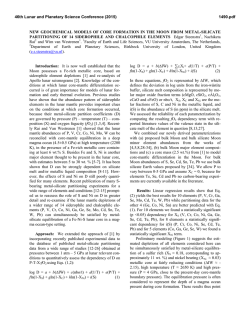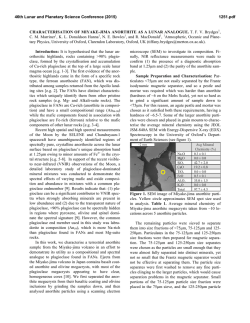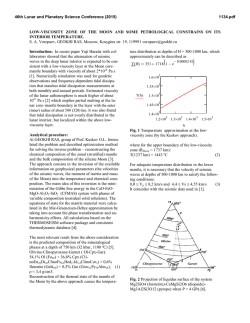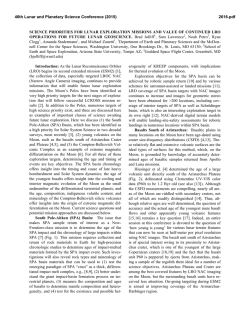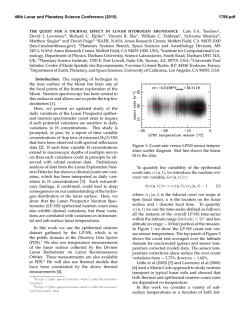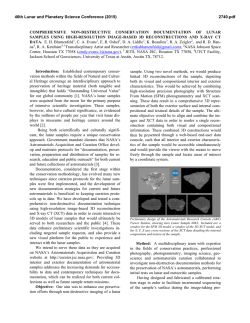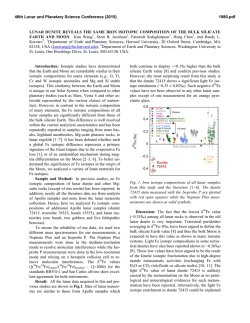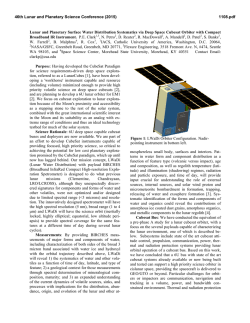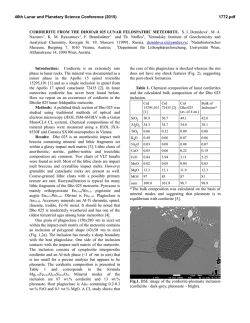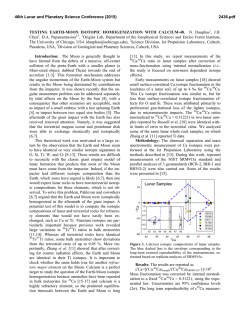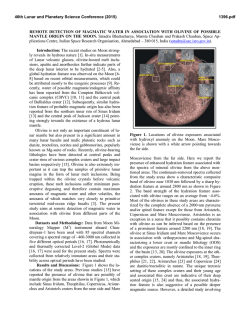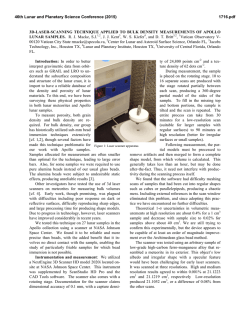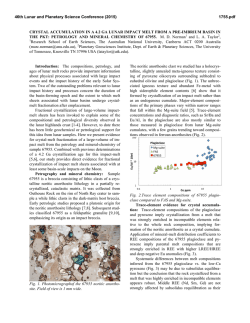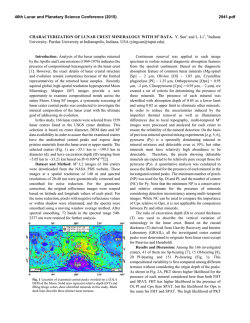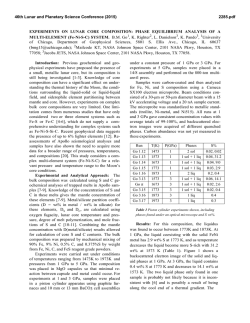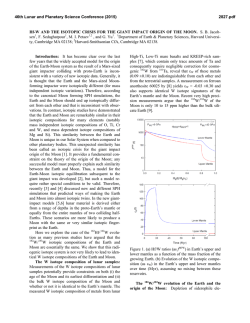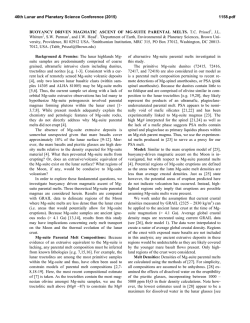
The Case for a Heat-Pipe Phase of Planet - USRA
46th Lunar and Planetary Science Conference (2015) 1184.pdf THE CASE FOR A HEAT-PIPE PHASE OF PLANET EVOLUTION ON THE MOON. J. I. Simon1, W. B. Moore2,3, A. A. G. Webb4, 1Center for Isotope Cosmochemistry and Geochronology, ARES, EISD-XI3, NASAJohnson Space Center, Houston, TX 77058, USA ([email protected]). 2Department of Atmospheric and Planetary Sciences, Hampton University, Hampton, VA 23668, USA ([email protected]). 3National Institute of Aerospace, Hampton, Virginia 23666, USA. 4Department of Geology and Geophysics, Louisiana State University, Baton Rouge, LA 70803, USA ([email protected]). Introduction: The prevalence of anorthosite in the lunar highlands is generally attributed to the flotation of less dense plagioclase in the late stages of the solidification of the lunar magma ocean [1, 2]. It is not clear, however, that these models are capable of producing the extremely high plagioclase contents (near 100%) observed in both Apollo samples [3] and remote sensing data [4], since a mostly solid lithosphere forms (at 60-70% solidification) before plagioclase feldspar reaches saturation (at ~80% solidification). Formation as a floating cumulate is made even more problematic by the near uniformity of the alkali composition of the plagioclase, even as the mafic phases record significant variations in Mg/(Mg+Fe) ratios [1]. These problems can be resolved for the Moon if the plagioclase-rich crust is produced and refined through a widespread episode of heat-pipe magmatism rather than a process dominated by density-driven plagioclase flotation. Heat-pipes are an important feature of terrestrial planets at high heat flow, as illustrated by Io’s present activity [5]. Evidence for their operation early in Earth’s history [6] suggests that all terrestrial bodies should experience an early episode of heat-pipe cooling. As the Moon likely represents the most wellpreserved example of early planetary thermal evolution in our solar system, studies of the lunar surface and of lunar materials provide useful data to test the idea of a universal model of the way terrestrial bodies transition from a magma ocean state into subsequent single-plate, rigid-lid convection or plate tectonic phases [7, Moore et al. (in review)]. The Heat-Pipe Hypothesis: Implications of heatpipes for the tectonic history of terrestrial bodies are illustrated in Figure 1 by contrasting the modeled evolution of the lithospheric thickness over time as heat generation decreases by a factor of four. Unlike the classic rigid-lid planet (blue) with a monotonically thickening lithosphere that tracks the equilibrium thickness (dashed), the heat-pipe planet (red) develops an early, thick lithosphere that is capable of recording and retaining early deformation events. Heat-pipe operation leads to: 1) Thick, cold, and strong lithospheres even though heat flow is high, 2) Dominance of compressive stresses as buried layers are forced to smaller radii, 3) Continuous replacement of lithospheric material, 4) High melt fraction (mafic to ultra-mafic) erup- tions, and 5) A rapid transition to rigid-lid or plate tectonic behavior. Figure 1: Modeled evolution of lithospheric thickness over time as internal heat production decreases by a factor of four (dashed line indicating equilibrium lithospheric thickness). Planets evolving through a heatpipe phase (red) develop a thick lithosphere early in their history, which thins as volcanism wanes and then thickens as rigid-lid convection takes over. Planets that transition directly from the magma ocean to rigid-lid convection (blue) begin with thin weak lithospheres that monotonically thicken and strengthen over time. The Lunar Case: In the heat-pipe scenario, the near-surface highland rocks are remelted by mafic magmas from the deep interior, producing melts that are higher in plagioclase while at the same time introducing a range of mafic components. This refinement process occurs through both density segregation of preexisting mafic minerals and remelting, liberating the more buoyant portion of the primitive upper mush (panel III of Figure 2). Repeated operation of this refining mechanism can result in the nearly pure plagioclase melts and textures of Apollo samples observed [3], while at the same time explaining the variations in Mg/(Mg+Fe) ratios seen in ferroan anorthite rich (FAN) rocks and the diversity of ferroan anorthositic materials contained in lunar meteorites [8]. Protracted heat-pipe volcanism/near surface intrusion is also consistent with current geochronological observations that indicate that there is significant overlap between the ages determined for the well-known “Mg suite” rocks 46th Lunar and Planetary Science Conference (2015) and the FANs. A global period of serial volcanism [9] eliminates the outstanding age problem with the standard lunar magma ocean model [10, 11], because the remelted [12] FANs would be related and thus coeval with intrusion of the mafic “Mg suite” rocks as opposed to being older as required by the standard magma ocean model [11]. The requirement for remelting earlier forming fractions of the lid appears consistent with recent evidence for relatively young (≤4.4 Ga) formation of FANs [13]. In addition to its unusual crustal chemistry, the Moon stands out as having a shape that is dramatically out of hydrostatic equilibrium even at the longest wavelengths. The Moon’s shape is not a fossil of a synchronous rotator at any distance from the Earth, but instead must record some other orbital and/or rotational state [14, 15]. The only means by which this record can be preserved over geologic time is substantial lithospheric strength, but all present explanations for the observed shape rely on processes that occur very early in the Moon’s evolution when it is much hotter. What is required is a way to rapidly produce a strong lithosphere even when the Moon is young and hot, which is precisely the expected behavior of a body experiencing heat-pipe cooling (Figure 1). The lithosphere is created rapidly and continuously, causing the shape to be recorded around the time the heat-pipe mechanism shuts off, and leaving behind a strong, distorted lithosphere. A Summary of Solutions to Outstanding Lunar Problems Resolved by an Early Phase of Heat-pipe on the Moon: (1) a physically realistic explanation for the purity of anorthosite in the lunar highlands, (2), a mechanism to produce the observed variations in Mg/(Mg+Fe) ratios seen in ferroan anorthite rich (FAN) rocks and the diversity of ferroan anorthositic materials contained in lunar meteorites, (3) a unifying concept consistent with recent geochronological evidence for younger formation of FANs, which require coeval evolution with intrusion of the mafic “Mg suite”, a significant discrepancy with the standard magma ocean model, and (4) underlying numerical model results that are consistent with the hydrostatically disequilibrium shape of the Moon requiring an early strong lithosphere. References: [1] Warren, P. H. (1985) Annual Review of Earth and Planetary Sciences 13, 201–240. [2] Elkins-Tanton, L. T., et al. (2011) EPSL 304, 326–336. [3] Haskin, L. A. et al. (1981) In LPSC vol. 12 of Lunar and Planetary Inst. Technical Report, 406–408. [4] Ohtake, M. et al. (2009) Nature 461, 236–240. [5] O’Reilly, T. C. and Davies, G. F. (1981) GRL 8, 313– 316. [6] Moore, W. B. & Webb, A. A. G. Heat-pipe Earth. (2013) Nature 501, 501–505. [7] Moore W. B. et al. (2014) LPSC Abst. #1941. [8] Gross, J. et al. 1184.pdf EPSL (2014) 388, 318–328. [9] Longhi, J. (2003) JGR (Planets) 108, 5083. [10] Wood, J. A. et al. (1970) Science 167, 602–604. [11] Shearer, C. K. et al. (2006) New Views of the Moon, 365–518. [12] Byrne, P. K. et al. (2014) Nature Geosci. 7, 301–307. [13] Borg, L. E. et al. (2011) Nature 477, 70–72. [14] Garrick-Bethell, I. et al (2006) Science 313, 652–655. [15] Matsuyama, I. (2013) Icarus 222, 411–414. I. Magma Ocean II. Magma Mush Planet WUDSSHGPDILFPLQHUDOV FRQYHFWLYHKHDWORVV KHDWORVVYLDLQWHUVWLWLDOPHOW FU\VWDOOL]HG ,,,(DUO\+HDW3LSHµVRUWLQJ¶ ,9+HDW3LSH9ROFDQLVP KRWWHUPDILFPDJPDVLQWUXGH QHDUVXUIDFHPXVKOHDGLQJWR EXR\DQF\GULYHQVHJUHJDWLRQ WKLFNµOLG¶RISODJLRFODVH ULFKFUXVWIRUPVE\ LQWUXVLRQDQGUHPHOWLQJ FU\VWDOOL]HG FU\VWDOOL]HG Figure 2: Stages of early lunar crustal differentiation: I. Magma ocean, II. Lithospheric-scale magma crystal mush, III. Early heat-pipe, where mafic melts pond beneath a plagioclase-bearing gabbroic crust allowing buoyant anorthositic melts and dense mafic crystals to separate, and IV. Mature heat-pipe cooling where the upper crust forms a thick, insulating lid of the observed highly enriched plagio-crust through the processes of dike intrusion and remelting.
© Copyright 2025
